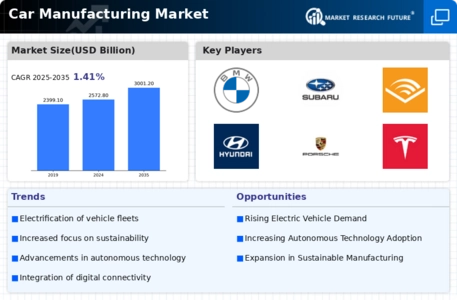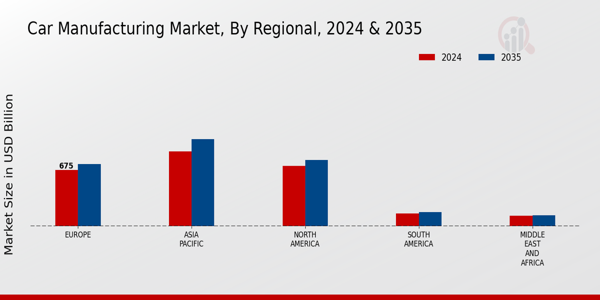Market Growth Projections
The Global Car Manufacturing Market Industry is poised for growth, with projections indicating a market value of 3001.2 USD Billion by 2035. This anticipated growth reflects a compound annual growth rate of 1.41% from 2025 to 2035. Factors contributing to this growth include technological advancements, rising consumer demand for electric vehicles, and evolving government regulations. As manufacturers adapt to these dynamics, the industry is likely to witness significant transformations in production processes and product offerings. The focus on sustainability and innovation will be paramount as the market evolves to meet future demands.
Technological Advancements
The Global Car Manufacturing Market Industry is experiencing rapid technological advancements, particularly in electric vehicle (EV) production and autonomous driving technologies. Innovations such as advanced driver-assistance systems (ADAS) and battery technology are reshaping the landscape. For instance, the integration of artificial intelligence in manufacturing processes enhances efficiency and reduces costs. As of 2024, the market is valued at 2572.8 USD Billion, reflecting the industry's adaptation to these technologies. Furthermore, the shift towards sustainable manufacturing practices is likely to drive growth, as consumers increasingly demand eco-friendly vehicles.
Global Supply Chain Dynamics
The Global Car Manufacturing Market Industry is significantly influenced by supply chain dynamics, particularly in the wake of geopolitical tensions and resource availability. The sourcing of raw materials, such as lithium for batteries, is becoming increasingly complex. Manufacturers are now focusing on establishing resilient supply chains to mitigate risks. As of 2024, the market is valued at 2572.8 USD Billion, with the potential for growth as companies adapt to these challenges. The ongoing evolution of supply chain strategies may lead to enhanced efficiency and cost-effectiveness, ultimately benefiting the industry as it moves towards a more sustainable future.
Government Regulations and Incentives
Government regulations play a crucial role in shaping the Global Car Manufacturing Market Industry. Stricter emissions standards and safety regulations are compelling manufacturers to innovate and adapt their offerings. Various countries are implementing incentives for electric vehicle purchases, which could bolster market growth. In 2024, the industry is valued at 2572.8 USD Billion, with projections indicating a compound annual growth rate of 1.41% from 2025 to 2035. These regulations not only promote sustainability but also create a competitive landscape where compliance becomes a key differentiator among manufacturers.
Rising Consumer Demand for Electric Vehicles
Consumer preferences are shifting towards electric vehicles, significantly impacting the Global Car Manufacturing Market Industry. This trend is driven by growing environmental awareness and government incentives promoting EV adoption. In 2024, the market's value is projected at 2572.8 USD Billion, with a notable increase expected as more manufacturers invest in electric models. The global push for carbon neutrality by 2035 is likely to further accelerate this demand, potentially leading to a market valuation of 3001.2 USD Billion. This shift not only influences production strategies but also necessitates a reevaluation of supply chains to accommodate new technologies.
Consumer Preferences for Connectivity and Safety Features
The demand for enhanced connectivity and safety features is reshaping the Global Car Manufacturing Market Industry. Consumers are increasingly seeking vehicles equipped with advanced infotainment systems and safety technologies, such as collision avoidance and lane-keeping assistance. This trend is likely to drive manufacturers to innovate continuously, ensuring their offerings meet evolving consumer expectations. In 2024, the market is valued at 2572.8 USD Billion, with projections suggesting that these features will become standard in future models. As manufacturers respond to this demand, the industry may witness a shift in design and functionality, aligning with consumer desires for smarter vehicles.

















